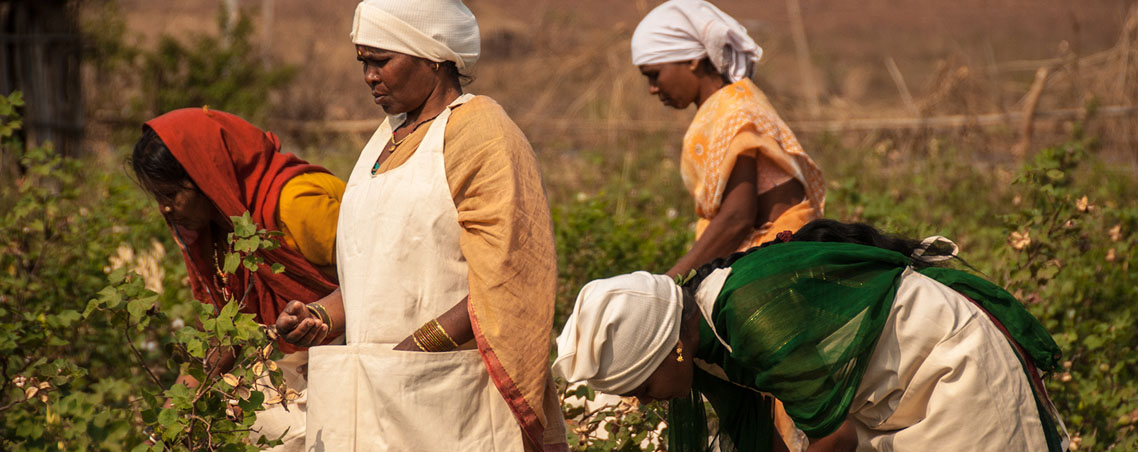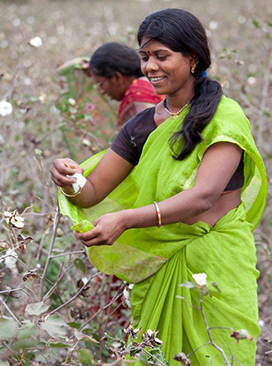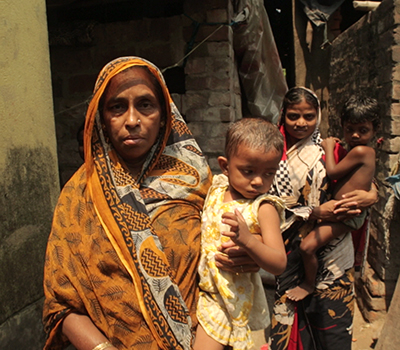Why Organic Cotton?

Hand-harvesting without harmful chemical defoliants. Organic farmers and gin workers are spared exposure to toxic chemicals and pesticides.
Cotton production has major impact.
One of the oldest fabrics developed by humankind, cotton commands up to 35% of the textile market and remains the most popular fiber in the world due to it’s natural comfort and breathability. China, India and USA grow almost two-thirds of the world’s cotton. Cotton is also a food crop; cottonseed oil is used in many processed and snack foods, and cottonseed is used in cattle feed.
Conventional cotton has devastating consequences.

Non GMO organic crops are healthier and more resilient
GMOs have taken over the conventional cotton industry. Genetically modified cotton accounts for a staggering 90- 95 per cent of cotton seed worldwide. Sterile GMO seeds break the natural cycle of regeneration and threaten bio-diversity, wildlife, and soil micro-organisms; all of which have damaging environmental implications. GMO farming shifts control and management from farmers to mega-corporations, since it is dependent on patented seeds and chemical applications. Despite a ban, the controversial Bt cotton, which incorporates a toxin to kill bollworm, now accounts for 93% of cotton grown in India. While it has brought short-term gains and lowered pesticide use against bollworm, non-target pest populations like aphids have exploded and overall pesticide use has risen. There is also increasing evidence that the Bt-toxin is harmful to humans and mammals when the crop is consumed.
Cotton has some of the highest pesticide and chemical use. Most pesticides were originally developed as toxic nerve agents during WWII and have been linked to cancers, neurological and developmental disorders. According to PANNA, nearly $3 billion worth of pesticides are sprayed on cotton fields each year —accounting for more than 10% of total pesticide use and nearly 25% of insecticide use worldwide. In fact the EPA considers 5 of the top 9 pesticides used on cotton as “likely” or “known” human carcinogens. Ironically, it is estimated that less than 10% of the chemicals applied to cotton accomplish their task, the rest are absorbed into the plant, air, soil, water and eventually end up in our bodies. When sprayed from the air, these highly toxic chemicals can poison farm workers and drift into surrounding neighborhoods. Pesticide applications contribute to major ecological damage and pollute ground and surface water, presenting an increasing danger to all wildlife, and esp. birds and bee populations. Bird deaths from pesticide poisonings are estimated at an astounding 72 million per year today. Spraying and even coating seed with neonicotinoids has become a common practice, making the pollen and nectar deadly to birds and bees that depend on it. Conventional cotton is also a major user of toxic herbicides, fungicides and defoliants. During processing, cotton is further subjected to chlorine bleach, heavy metal dyes and formaldehyde resins, the hidden hazard of ‘wrinkle free’ and ‘stain resistant’ treatments.

Organic farming is safer for workers

Pesticides on non-organic farms harm rural families
Conventional cotton growing presents a danger to farmers. According to a WHO estimate, up to 40,000 deaths and 3 million cases of health problems are directly caused by agricultural pesticide poisoning each year. Moreover, conventional farmers become dependent on profit driven corporations for expensive seed and pesticide purchase. As insects and weeds gradually become resistant, ever-increasing amounts are applied to be effective, leaving farmers helplessly caught on the pesticide treadmill. Approx. 10,000 farmers in India commit suicide each year when faced with devastated fields, contaminated water wells and mounting debt. Rural workers forced to abandon their livelihood often end up in slum city dwellings in deplorable conditions.
The organic alternative is better.
Our cotton is grown, processed, dyed and made into clothing according to organic standards. This simply means that the entire production chain follows strict organic processes to provide a completely environmental product.
Organic cotton is grown with natural means and uses sustainable practices. These include manual farming, using high quality resilient seed varieties, crop rotation, water conserving methods and botanical pest control. The soil is enriched and healthy so it requires fewer external applications and treatments. Many of our farmers follow bio-dynamic practices, strengthening an age-old Indian belief in a spiritual connection with soil.
The eco-friendly processing uses recycled water, biofuels, reduces electric use and conserves and recycles resources. Our dye unit has an on-site effluent treatment plant to prevents toxic runoff. We use non-chlorine bleach, silicone-free softeners and low impact, azo-free dyes that do not create a hazard to health and environment. Scraps off the cutting table are recycled.
Strict testing is conducted to ensure the absence of hazardous elements like nickel, lead, formaldehyde, amines, pesticides and heavy metals.

Rice husk used for biofuel at our dye factory

